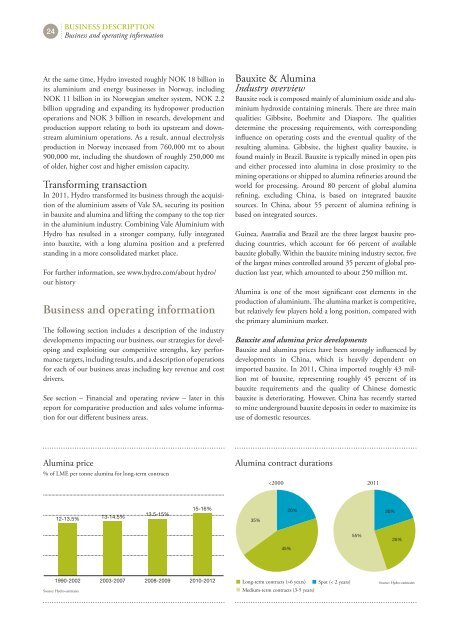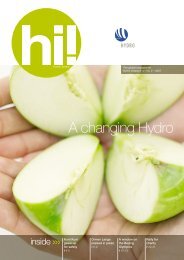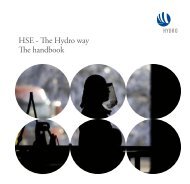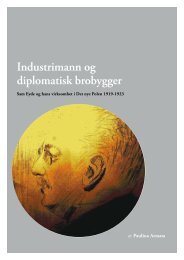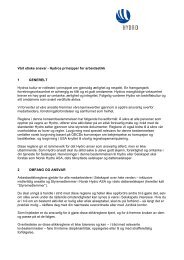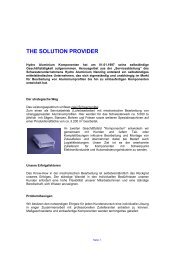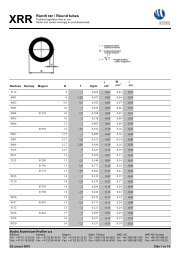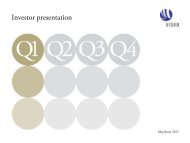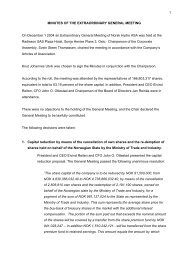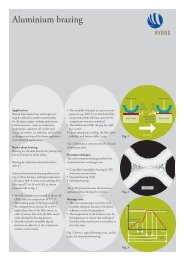Hydro Annual Report 2011b
Hydro Annual Report 2011b
Hydro Annual Report 2011b
Create successful ePaper yourself
Turn your PDF publications into a flip-book with our unique Google optimized e-Paper software.
24<br />
BusIness DesCrIptIon<br />
Business and operating information<br />
At the same time, <strong>Hydro</strong> invested roughly NOK 18 billion in<br />
its aluminium and energy businesses in Norway, including<br />
NOK 11 billion in its Norwegian smelter system, NOK 2.2<br />
billion upgrading and expanding its hydropower production<br />
operations and NOK 3 billion in research, development and<br />
production support relating to both its upstream and downstream<br />
aluminium operations. As a result, annual electrolysis<br />
production in Norway increased from 760,000 mt to about<br />
900,000 mt, including the shutdown of roughly 250,000 mt<br />
of older, higher cost and higher emission capacity.<br />
Transforming transaction<br />
In 2011, <strong>Hydro</strong> transformed its business through the acquisition<br />
of the aluminium assets of vale SA, securing its position<br />
in bauxite and alumina and lifting the company to the top tier<br />
in the aluminium industry. Combining vale Aluminium with<br />
<strong>Hydro</strong> has resulted in a stronger company, fully integrated<br />
into bauxite, with a long alumina position and a preferred<br />
standing in a more consolidated market place.<br />
for further information, see www.hydro.com/about hydro/<br />
our history<br />
Business and operating information<br />
The following section includes a description of the industry<br />
developments impacting our business, our strategies for developing<br />
and exploiting our competitive strengths, key performance<br />
targets, including results, and a description of operations<br />
for each of our business areas including key revenue and cost<br />
drivers.<br />
See section – financial and operating review – later in this<br />
report for comparative production and sales volume information<br />
for our different business areas.<br />
Alumina price<br />
% of LME per tonne alumina for long-term contracts<br />
12-13.5%<br />
1990-2002<br />
Source: <strong>Hydro</strong> estimates<br />
13-14.5%<br />
2003-2007<br />
13.5-15%<br />
2008-2009<br />
15-16%<br />
2010-2012<br />
Bauxite & Alumina<br />
Industry overview<br />
Bauxite rock is composed mainly of aluminium oxide and aluminium<br />
hydroxide containing minerals. There are three main<br />
qualities: Gibbsite, Boehmite and Diaspore. The qualities<br />
determine the processing requirements, with corresponding<br />
influence on operating costs and the eventual quality of the<br />
resulting alumina. Gibbsite, the highest quality bauxite, is<br />
found mainly in Brazil. Bauxite is typically mined in open pits<br />
and either processed into alumina in close proximity to the<br />
mining operations or shipped to alumina refineries around the<br />
world for processing. Around 80 percent of global alumina<br />
refining, excluding China, is based on integrated bauxite<br />
sources. In China, about 55 percent of alumina refining is<br />
based on integrated sources.<br />
Guinea, Australia and Brazil are the three largest bauxite producing<br />
countries, which account for 66 percent of available<br />
bauxite globally. Within the bauxite mining industry sector, five<br />
of the largest mines controlled around 35 percent of global production<br />
last year, which amounted to about 250 million mt.<br />
Alumina is one of the most significant cost elements in the<br />
production of aluminium. The alumina market is competitive,<br />
but relatively few players hold a long position, compared with<br />
the primary aluminium market.<br />
Bauxite and alumina price developments<br />
Bauxite and alumina prices have been strongly influenced by<br />
developments in China, which is heavily dependent on<br />
imported bauxite. In 2011, China imported roughly 43 million<br />
mt of bauxite, representing roughly 45 percent of its<br />
bauxite requirements and the quality of Chinese domestic<br />
bauxite is deteriorating. However, China has recently started<br />
to mine underground bauxite deposits in order to maximize its<br />
use of domestic resources.<br />
Alumina contract durations<br />
35%<br />
6 years) Spot (< 2 years)<br />
Medium-term contracts (3-5 years)<br />
55%<br />
20%<br />
25%<br />
Source: <strong>Hydro</strong> estimates


